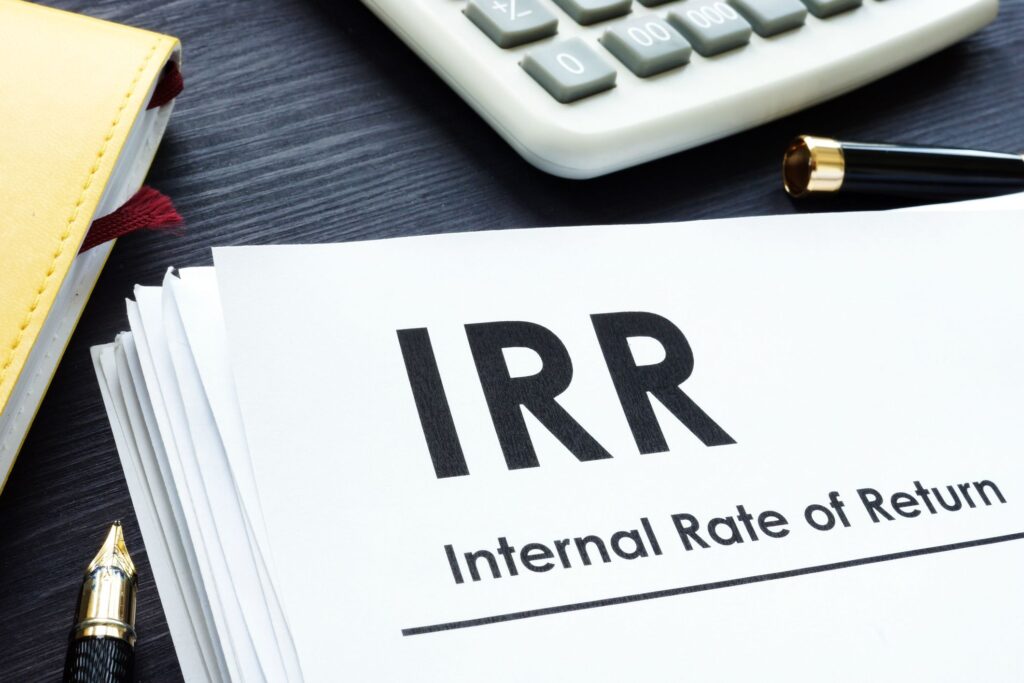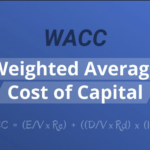
By ATGL
Updated March 17, 2024
Imagine investing with a crystal ball, predicting exactly how much profit your money will earn. While that remains fantasy, the Internal Rate of Return comes close as a financial oracle. IRR is the magician of the investment world, revealing the potential profitability of your ventures.
Exploring the labyrinth of financial analysis, we unveil the essence of IRR — a metric that balances complex calculations with insightful projections for growth. Calculating IRR and understanding its implications is critical for any serious investor or financial professional.
Within the following sections, we will dissect every facet of IRR, from its basic definition to its profound influence on investment strategy. Prepare to navigate the nuances of calculating a “good” IRR, utilizing it in decision-making, and appreciating its strengths and weaknesses in the intricate dance of dollars and sense.
Internal or Annual Rate of Return (IRR) Explained
The Internal Rate of Return (IRR) is a critical financial metric used by investors and businesses to understand the efficiency of their investments. IRR is commonly referred to as the annual growth rate that equates the present value of the future cash flows from an investment with the initial investment amount. In simpler terms, it is the discount rate that makes the net present value (NPV) of all cash flows (both positive and negative) from a particular investment equal to zero.
When considering prospective projects or investments, knowing the IRR enables investors and capital management professionals to gauge an investment’s performance. For example, if an investment displays a 10% IRR, this suggests that the project is expected to yield a 10% annual rate of return over the period of time the investment is held.
To determine if their financial decisions will be worthwhile, investors often compare the IRR of a potential investment against their required hurdle rate or cost of capital, which reflects the risks associated with the investment. The IRR provides a universal measurement by accounting for the time value of money through its discount rate—an approach that translates future cash flows into today’s dollars.
Understanding IRR is invaluable in the realm of fixed-income securities, private equity firms, and virtually any venture where the timing and magnitude of cash flows are crucial determinants of success. It informs investment decisions, guiding investors to the projects likely to provide the most significant return on investment while also aligning with their risk tolerance and capital management strategies.
How To Calculate the IRR and Its Variations
Calculating the IRR can be a complex activity, as it typically involves finding the discount rate that results in a zero NPV for a series of cash flows. Specifically, the process often requires using trial-and-error, wherein analysts will estimate the IRR using progressively refined discount rates until the NPV reaches zero.
There are several tools available to assist in determining the IRR. Many financial analysts turn to the built-in functions of spreadsheet software like Excel, which offers IRR, XIRR, and MIRR functions tailored to different types of cash flow scenarios. For instance, IRR is typically used when the cash flows are regular, such as annual cash flows, while XIRR is best suited for cash flows occurring at irregular time periods. MIRR, meanwhile, provides a modification by assuming reinvestment at potentially different rates than the IRR.
Alternatively, financial calculators, both online and physical, with specific IRR functions can simplify the calculation process, providing quicker results. However, to manually compute the IRR, one could apply the formula:
IRR = (Future Value / Present Value)^(1 / Number of Periods) – 1,
which offers an insight into the investment’s performance over time. Despite the formula’s appearance, it is important to remember that future values, costs of capital, and the timing of the cash flows all play a role in the accurate calculation of IRR.
What Is a Good IRR?
A “good” IRR largely depends on the context of the investment under consideration, as well as the investor’s own criteria, such as their risk tolerance and the benchmark return rates within the industry. For example, private equity firms engaged in leveraged buyouts might target an IRR of 20%, which they consider the acceptable rate for the risk and effort involved.
Because industries and circumstances vary, so do expectations for IRR. For sectors with higher inherent risks, such as technology startups or biotechnology firms, investors might expect a higher IRR to compensate for the potential risk of loss. Conversely, in stable industries, a lower IRR might be acceptable.
Relative to the hurdle rate, which generally corresponds to a company’s average cost of capital or a certain percentage rate reflecting minimal expectations, a good IRR would be one that exceeds this benchmark, validating the investment decision. In real estate, a strong IRR is often considered to be in the realm of 12% to 20%.
Benefits of the IRR Rule To Make Investment Decisions
The IRR rule is a crucial axiom in the field of investment and corporate finance for simplifying complex decision-making processes. The rule propounds that if the IRR exceeds the hurdle rate—often the company’s weighted average cost of capital or WACC—the investment is considered viable and should theoretically be accepted. Conversely, if the IRR falls short of the hurdle rate, it may be wise to reject the project in favor of more profitable ones.
The benefit of using the IRR rule lies in its ability to provide a quick and streamlined valuation that can aid businesses and investors in comparing the profitability of different investment opportunities. An investment with a higher IRR is expected to yield greater net cash flows over time, which is a persuasive argument for proceeding with the investment.
However, the rule is not without criticism, as it does not account for the scale of the investment, nor the potential differences in capital requirements for each project. Nonetheless, as a standalone metric, the IRR is an essential component of any rigorous financial analysis.
Evaluate Investment Profitability and Annual Growth Rate
When evaluating investment profitability and annual growth rate, the Internal Rate of Return (IRR) is a financial metric that serves as a critical tool. IRR calculates the percentage rate at which the present value of future cash flows from an investment equals the initial investment, effectively bringing the net present value (NPV) to zero. This calculation incorporates both the cost of capital and the time periods over which returns are generated, thus respecting the time value of money.
A good IRR exceeds the company’s hurdle rate, also known as the minimum acceptable rate of return, which accounts for the risk tolerance and capital management objectives of the investor.
Here’s how to assess IRR in a simple manner:
- Identify all cash flows associated with the investment, including both positive cash flows (income) and potential negative cash flows (expenses).
- Use the IRR formula or a financial calculator to solve for the discount rate that makes the NPV of these cash flows equal to zero.
Remember, a higher IRR suggests a more attractive investment opportunity, but it must be weighed against other considerations, such as risk and the duration of the investment. Private equity firms and individual investors alike use IRR in conjunction with other indicators to make comprehensive investment decisions and manage their financial portfolios effectively.
Analyze Fixed-Income Securities
When analyzing fixed-income securities, the Internal Rate of Return (IRR) stands as a crucial metric. It serves to gauge the profitability and viability of these investments, akin to the yield to maturity and yield to call for bonds. The IRR encapsulates the percentage rate at which invested funds would break even, considering the expected cash flows over the bond’s life. It effectively merges the time value of money with a bond’s expected returns, offering a comprehensive view of the investment’s potential.
In the landscape of fixed income, IRR provides clarity on whether an investment aligns with a firm’s capital management strategies. It answers the question, “What is a good IRR?” by allowing the comparison of the investment’s rate of return against the company’s cost of capital or hurdle rate, which reflects the minimum required rate of return. For this reason, financial analysts diligently calculate IRR to guide investment decisions.
Key considerations when utilizing IRR for fixed-income securities analysis include:
- Time periods: Cash flows are distributed over several years.
- Positive and negative cash flows: All inflows and outflows are accounted for.
- Discount rate: Reflects investors’ risk tolerance and required returns.
- Initial investment: Provides a baseline for measuring the return rate.
By integrating these elements into the financial analysis, private equity firms can effectively manage their portfolios, ensuring each potential investment aligns with their risk tolerance and expected rates of return.
Guide Capital Management
Capital management is an essential aspect of any business, ensuring that it makes sound investment decisions to drive growth. A pivotal tool in this process is the Internal Rate of Return (IRR), which is fundamental in evaluating the potential profitability of projects and investments. The IRR calculates the annual growth rate that makes the net present value (NPV) of all cash flows (both positive and negative) from a particular project equal to zero.
Here’s a quick breakdown of the IRR’s importance in capital management:
- IRR Rule: When deciding on where to allocate capital, firms compare the IRR of a potential investment against the company’s cost of capital or hurdle rate. Generally, if the IRR exceeds this threshold, it indicates a viable investment.
- Flexible Decision-Making: While the IRR is a critical figure, it’s not the only consideration. Companies also weigh in other variables such as risk tolerance, market conditions, and project scale.
- Comprehensive Analysis: Together with the IRR, financial metrics like Net Present Value (NPV) are used to paint a broad picture of an investment’s potential, helping firms reach balanced investment decisions.
A “good” IRR is one that surpasses the hurdle rate, reflecting a solid return on investment (ROI) over the period of time being considered. Combining the IRR with a financial analysis of future cash flows, companies can adeptly manage capital, balancing between risk and potential gains and ensuring sustained profitability.
In sum, IRR is more than a percentage rate—it’s a comprehensive financial metric integral to capital management and strategic investment decisions.
Measure Private Equity Performance
When assessing the performance of private equity investments, an indispensable metric is the Internal Rate of Return (IRR). Typically, leveraged buyout transactions within private equity aim for an IRR of around 20%. IRR is a financial metric representing the annual growth rate that an investment is expected to generate. However, the timing of cash flows can distort the IRR, making it crucial for investors to look beyond superficial rates of return.
In private equity, a high IRR can sometimes result more from an expedited return of capital rather than actual growth in the investment’s value. To get a more comprehensive understanding of an investment’s performance, private equity firms commonly utilize both net present value (NPV) and IRR for financial analysis. Evaluating these two metrics provides insights into the potential investment’s profitability while considering the average cost of capital.
Private Equity Performance Evaluation:
- Minimum IRR Requirement: ~20% for leveraged buyouts
- IRR Distortion: Can be swayed by cash flow timings
- High IRR: May indicate fast capital return, not necessarily substantive growth
- Comparative Analysis: Using IRR to juxtapose new and existing investment opportunities
- NPV & IRR: Dual assessment for comprehensive investment decisions
Understanding IRR in relation to time periods and risk tolerance is vital as it influences the determination of an acceptable rate, guiding capital management and investment decisions.
Limitations of IRR and Real Dollar Investments
Despite its widespread usage and inherent benefits, IRR presents several limitations, particularly when it comes to real dollar investments. The metric does not account for the size of the project; hence, it may favor smaller projects with high rates of return, even if larger projects could offer greater total dollar returns. Furthermore, IRR assumes that positive cash flows are reinvested at the same rate, which may not be realistic, as these funds could be reinvested at varying rates.
Another notable limitation stems from the IRR’s focus on rates of return rather than actual dollar amounts. While IRR provides a rate that sets the NPV to zero, it does not convey the magnitude of an investment’s value in real dollar terms.
Lastly, irregular cash flows or multiple changes in cash flow directions—if an investment alternates between generating positive and negative cash flows—can result in multiple IRRs, which complicates the decision-making process. Ultimately, using IRR in isolation can present a skewed viewpoint, potentially leading to suboptimal investment decisions. It’s essential, therefore, to supplement IRR with other analyses and context-specific information to achieve a comprehensive financial analysis and make well-informed investment decisions.
Secure Your Return on Investment With Above the Green Line
Securing a robust return on investment (ROI) is paramount in capital management, a principle championed by investment strategy companies like Above the Green Line. This firm educates investors on optimizing their portfolios using metrics such as the Internal Rate of Return (IRR).
The IRR, a critical financial metric, serves as a compass for investment decisions, signaling the annual growth rate at which future cash flows equate to the initial investment, thus ensuring a project’s profitability. It’s like finding the equilibrium point where the investment neither gains nor loses value, encapsulating the concept of ‘break-even.’
Investment strategies must hurdle the cost of capital, making IRR integral. A ‘good IRR’ surpasses this hurdle rate, aligning with one’s risk tolerance. However, to secure investment sustainability, Above the Green Line suggests that IRR should be viewed in tandem with other measures like NPV, ensuring a comprehensive financial analysis.
Investors chasing projects with incentives such as Feed-In Tariffs (FIT) may find their IRR bolstered, tipping the scales toward a more favorable investment landscape. Remember, a diligent investor combines IRR with insight from seasoned strategists to navigate the dynamic world of returns successfully. Join Above the Green Line today.





